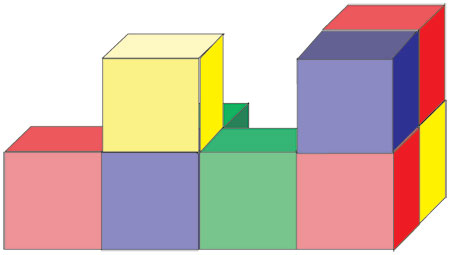Copyright © University of Cambridge. All rights reserved.
'Castles in the Middle' printed from https://nrich.maths.org/
Show menu
Why do this problem?
This task encourages the development of team-building skills such as sharing reasoning, allowing everyone to contribute and valuing those contributions, and coming to a consensus. This is one of a series of problems designed to develop learners' team-working skills. Other tasks in the series can be found by going to this article. In addition learners are expected to use precision in describing the arrangement of the cubes.
Possible approach
If learners have never worked on this sort of problem before it is best to choose no more than six cubes, each of a different colour. You might also wish to add some additional constraints, such as:
- all castles have at least one line of symmetry,
- all castles have at least two turrets.
You will need a screen or cloth to hide the designer's arrangement. See **below.
Arrange learners in groups of four or five (five allows one to act as an observer).
You may wish to ask teams to record their questions before asking them. Then, as part of their review of the task, the team can discuss what may have been a more efficient set of questions to ask.
Cards for each role:
- The rule cards for questioning can be found here: word, pdf.
- The role card for designers can be found here: word, pdf.
- The role card for observers can be found here: word, pdf.
When teams have finished working on the task it is important that they spend time discussing in groups, and then as a whole class, how well they worked as a team, what they have learned from the experience and what they would do differently next time. Your own observations, as well as those of observers might inform the discussions.
**You may prefer to prepare some images of an arrangement first to hand out to designers. Designers then answer the team questions, making a note of the number of questions asked. The team records each question before asking it. When the groups have finished you might discuss the number of questions used and ask the team with the fewest questions to share their ideas with the rest of the
group.
Key questions
- What things did you hear someone else say that you found really helpful?
- How well did you listen to others in your group?
- How easy was it to come to an agreement about the questions to ask?
- Did everyone always agree and what did you do if you did not?
Possible extension
Increase the number of cubes available, so that there are multiple cubes of the same colour.
Learners may like to try one of the other 'All for one' tasks. Other skill-building tasks can be found by going to this article.
Possible support
Reduce the number of cubes available and make sure each is a different colour.
Allow the designer to give a colour as an answer.
Make a list of the allowed questions, such as:
- How many cubes are there?
- What colour is the cube to the left of the red cube?
- Is the cube on top of/below the red cube blue?
- Is there a cube behind/infront of the blue cube?
